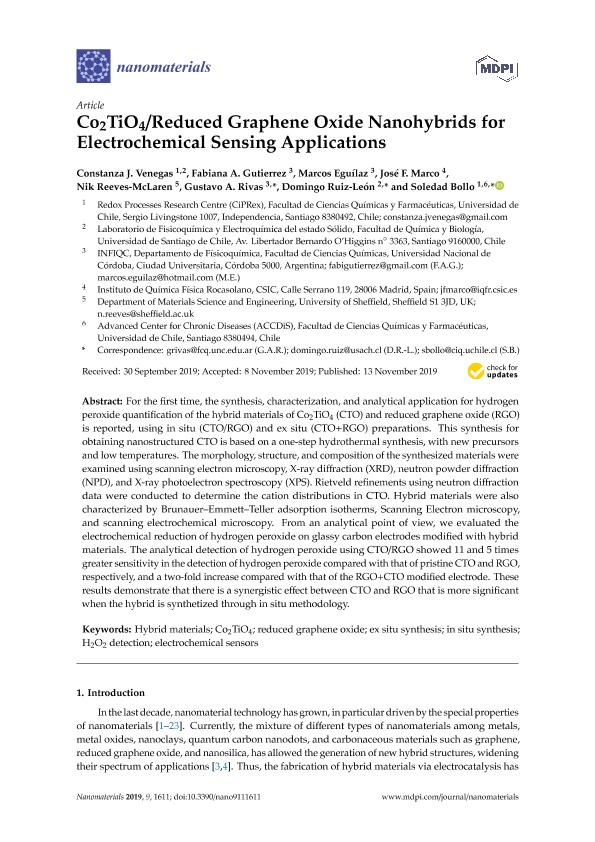Artículo
Co2TiO4/reduced graphene oxide nanohybrids for electrochemical sensing applications
Venegas, Constanza J.; Gutierrez, Fabiana Andrea ; Eguílaz Rubio, Marcos
; Eguílaz Rubio, Marcos ; Marco, José F.; Reeves-McLaren, Nik; Rivas, Gustavo Adolfo
; Marco, José F.; Reeves-McLaren, Nik; Rivas, Gustavo Adolfo ; Ruiz-León, Domingo; Bollo, Soledad
; Ruiz-León, Domingo; Bollo, Soledad
 ; Eguílaz Rubio, Marcos
; Eguílaz Rubio, Marcos ; Marco, José F.; Reeves-McLaren, Nik; Rivas, Gustavo Adolfo
; Marco, José F.; Reeves-McLaren, Nik; Rivas, Gustavo Adolfo ; Ruiz-León, Domingo; Bollo, Soledad
; Ruiz-León, Domingo; Bollo, Soledad
Fecha de publicación:
11/2019
Editorial:
MDPI AG
Revista:
Nanomaterials
e-ISSN:
2079-4991
Idioma:
Inglés
Tipo de recurso:
Artículo publicado
Clasificación temática:
Resumen
For the first time, the synthesis, characterization, and analytical application for hydrogen peroxide quantification of the hybrid materials of Co2TiO4 (CTO) and reduced graphene oxide (RGO) is reported, using in situ (CTO/RGO) and ex situ (CTO+RGO) preparations. This synthesis for obtaining nanostructured CTO is based on a one-step hydrothermal synthesis, with new precursors and low temperatures. The morphology, structure, and composition of the synthesized materials were examined using scanning electron microscopy, X-ray diffraction (XRD), neutron powder diffraction (NPD), and X-ray photoelectron spectroscopy (XPS). Rietveld refinements using neutron diffraction data were conducted to determine the cation distributions in CTO. Hybrid materials were also characterized by Brunauer-Emmett-Teller adsorption isotherms, Scanning Electron microscopy, and scanning electrochemical microscopy. From an analytical point of view, we evaluated the electrochemical reduction of hydrogen peroxide on glassy carbon electrodes modified with hybrid materials. The analytical detection of hydrogen peroxide using CTO/RGO showed 11 and 5 times greater sensitivity in the detection of hydrogen peroxide compared with that of pristine CTO and RGO, respectively, and a two-fold increase compared with that of the RGO+CTO modified electrode. These results demonstrate that there is a synergistic effect between CTO and RGO that is more significant when the hybrid is synthetized through in situ methodology.
Archivos asociados
Licencia
Identificadores
Colecciones
Articulos(INFIQC)
Articulos de INST.DE INVESTIGACIONES EN FISICO- QUIMICA DE CORDOBA
Articulos de INST.DE INVESTIGACIONES EN FISICO- QUIMICA DE CORDOBA
Citación
Venegas, Constanza J.; Gutierrez, Fabiana Andrea; Eguílaz Rubio, Marcos; Marco, José F.; Reeves-McLaren, Nik; et al.; Co2TiO4/reduced graphene oxide nanohybrids for electrochemical sensing applications; MDPI AG; Nanomaterials; 9; 11; 11-2019; 1-18
Compartir
Altmétricas



